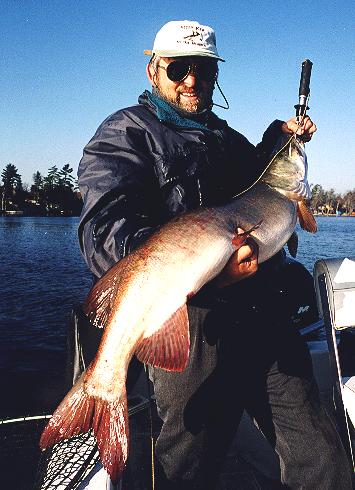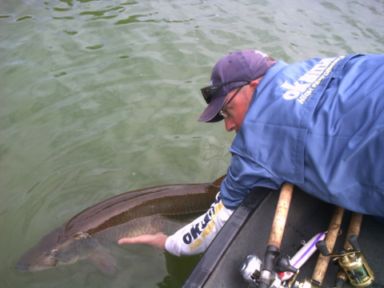|
|
| I'm not very adept at trolling and I have questions about running depth....
I found a neat little program that calculates lure depth by using line out and line angle, assuming planer boards or downriggers are being used.
Is this all that is needed to calculate lure depth or does lure weight, bill angle/placement/shape, etc., play a part in a lure's trolling depth?
If the program actually works, how the heck does a guy figure the line angle????????
Thanks
| |
| | |
Posts: 1247
Location: On the Niagara River in Buffalo, NY | A seasoned troller knows exactly where his crankbaits are from the boat,both in distance from and depth,for exact placement behind structure etc..Using someone elses written dive curves will get you in the ball park,but not exactly where you think the crankbaits are.There are just many varibales,line size and type,rod distance from the boat to the water,speed and crankbait running trait.Some lines will cut the water more for deeper running of your crankbaits others will rise because of the diameter with higher speeds etc..The higher your rod is from the water the more angle your line has going into the water,less depth then a boat close to the water with the same amount of line out.Every crankbait is not equal either,they may look the same out of the package and may even look like they are working the same next to the boat.But let one crankbait out until your crunching bottom,reel up so that your only ticking from time to time.Now look at how much line you have out,if no linecounter count the number of passes of the level wind as you reel it up,or 1/2 hitch on a peice of dental floss to mark the spot.Put on the other identical crankbait and let the line out to the same spot,go slow on the line out the last few feet,you may hit bottom with less line out or you may take even more.But every crankbait needs to be tested this way to know the exact depth.Then you need to find a peice of structure to troll the crankbaits that you have learned the depth of into,so you can learn the distance back relationship of the crankbaits,how far they are from the boat so you know when to turn to place them behind structure.One must learn to tune lures,find the running depth through testing,by speed and line type,to be consistantly successful at trolling and catching big hawg's!
Capt. Larry D. Jones
http://www.mostlymuskies.com/reports.htm | |
| | |

Posts: 132
Location: Kawarthas, Ontario | Larry's answer is pretty much bang-on. Those of us that do troll "know" exactly how to put each bait we utilize precisely where we want it. (We also know the limitations of each bait in terms of speed, versatility, and longevity.) Your line type, and size (diameter), your leader, boat speed, current, rod length, rod angle, and the size and model of lure you're using are the primary variables, but there can be others. The best way to find out is to experiment. Once you know how a particular lure contacts the bottom with about 3 different set-back lengths (and at a particular speed), you pretty much have the dive angle, and can calculate the line-out you need to achieve the depth that you want. If you're only using 3 or 4 different baits, you can map this out in a day. If you've got a variety of baits and sizes, this can take weeks. Of course, if you change your equipment, or introduce current into the equation by fishing a new body of water, you could be back at square 1.
There is no quick fix or easy answer. This takes time on the water. It's a key part of the "learning curve" if you want to be an effective troller.
Steve Wickens
STRIKE ZONE Muskie Charters
Edited by strike_zone 12/11/2003 7:55 AM
| |
| | |

Posts: 3242
Location: Racine, Wi | I by no means am an expert troller, but take Larry and Steve's advice, and a notebook along to record your findings. On the days that are a little slow for the 'skies, start working the baits in a certain depth, and record all info related to the bait, ie line type, speed, line out, angle of the rod etc. It will take time, but you will develope your personal encyclopedia of crank trolling info. I'm sure the guys that are trolling all the time started out the same way, and have a personal log of these running depths.
Good lungen,
Joel | |
| | |

Posts: 78
Location: Pardeeville, WI | Im still just a beginner but one thing that helped me out greatly was getting a line counter reel this year. The reel is a Penn and is great for trolling but horrible for casting.
How it helps is, say you take a bait and put it out 20 feet. Then you cruise into shallow water and watch your locator. The minute it hits the bottom mark the depth down. Then experiment with different amounts of length like 30 feet, 40 feet, etc... You get the idea.
You dont need all line counters as you will remember or you can right it down and print it out and put it in with your maps. You could almost make like an excel spreadsheet that says something like:
This is just an example.
Believer] Deep eye] 20 feet of line out] Dives 12 feet deep @ 3.5mph
Headshaker] 20 feet of line out] Dives 7 feet deep @ 3.5
It takes a while but it is worth it to know exactly how deep your running.
Another benefit of the line counter is lets say your trolling with a stalker and you nail a musky 18 feet behind the boat. Once you get the fish back in the water start trolling again at exactly 18 feet back. Add another bait that runs at that certain depth also.
I nailed 3 nice pike within 20 minutes last fall trolling and they all came on the rod that was running at 18 feet back. Believe me next time I hit that river during that time of the year im going to be running that same bait 18 feet back no questions asked.
Trust me get a line counter as it speeds up the learning curve on trolling.
Edited by BTPF 12/11/2003 1:43 PM
| |
| | |
Posts: 585
Location: Gaithersburg, Maryland | I might add to BTPF's post that you should do this where there is a hard bottom. Otherwise you may think your lure is deeper than it really is. | |
| | |
| Thank for all the advice.
Here's another one:
How are you determining the lure's depth? Can you see it on the fishfinder?
| |
| | |

Posts: 3242
Location: Racine, Wi | You have to run a certain contour with your bait. Baisically, run at a constant 12 feet on the locator. Then let line out until you feel the bait bouncing off of the bottom. Bring in some line until you feel it occasionally hit the bottom. Write down how much line out, what line you are using, and the speed. Clip on the next bait, and start over again, or move to a different depth, and start the process over with the same bait. It will take some time, but the effort is well worth it. Remember, you don't always have to troll deep. There are some good trolling patterns that take you shallow with short lines as well. That's another can of worms though.
Good Lungen,
Joel | |
| | |

Posts: 132
Location: Kawarthas, Ontario | Sand bottom is a great way to test lures, and easier on the lips. Deep weeds or even mud can also work too. But you need that contact to identify the running depth of the lure, and you need 3 good readings to establish a pattern for any bait.
Regards,
Steve Wickens
STRIKE ZONE Muskie Charters | |
| | |
| Here is an example. Let out 30FOL, take a tapemeasure and hold the tip of the rod at one foot from the suface. measure from the tip to where the line enters the water. Let's say it is three feet from tip to where the line enters the water. That means the lure goes one foot down for every three feet of line out. Thirty divided by three is ten, so the lure is running ten feet down. This is not constant becouse less line out a lure dives at a steeper angle and more line out a shallower angle. Keep a notebook and log where different lures run with different amounts of line and weight. Water density changes with temperature and this affects how deep a lure runs on a given amount of line. If you run the rod tips down in the water you have to add this depth also. Later | |
| | |

Posts: 3913
| Read Bucher's "Crankbait Secrets" book for some terrific trolling ideas. | |
| | |

Location: Des Moines IA | I agree on the Crankbait Secrects. Read it once while at Jury Duty. Will definately read it again before Open Water! | |
| |
|
 Calling all trolling experts
Calling all trolling experts Calling all trolling experts
Calling all trolling experts